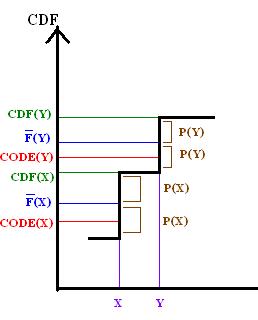Top Qs
Timeline
Chat
Perspective
Shannon–Fano–Elias coding
Algorithm for binary prefix code From Wikipedia, the free encyclopedia
Remove ads
In information theory, Shannon–Fano–Elias coding is a precursor to arithmetic coding, in which probabilities are used to determine codewords.[1] It is named for Claude Shannon, Robert Fano, and Peter Elias.
This article needs additional citations for verification. (April 2016) |
Algorithm description
Summarize
Perspective
Given a discrete random variable X of ordered values to be encoded, let be the probability for any x in X. Define a function
Algorithm:
- For each x in X,
- Let Z be the binary expansion of .
- Choose the length of the encoding of x, , to be the integer
- Choose the encoding of x, , be the first most significant bits after the decimal point of Z.
Example
Let X = {A, B, C, D}, with probabilities p = {1/3, 1/4, 1/6, 1/4}.
- For A
- In binary, Z(A) = 0.0010101010...
- code(A) is 001
- For B
- In binary, Z(B) = 0.01110101010101...
- code(B) is 011
- For C
- In binary, Z(C) = 0.101010101010...
- code(C) is 1010
- For D
- In binary, Z(D) = 0.111
- code(D) is 111
Remove ads
Algorithm analysis
Summarize
Perspective
Prefix code
Shannon–Fano–Elias coding produces a binary prefix code, allowing for direct decoding.
Let bcode(x) be the rational number formed by adding a decimal point before a binary code. For example, if code(C) = 1010 then bcode(C) = 0.1010. For all x, if no y exists such that
then all the codes form a prefix code.
By comparing F to the CDF of X, this property may be demonstrated graphically for Shannon–Fano–Elias coding.
By definition of L it follows that
And because the bits after L(y) are truncated from F(y) to form code(y), it follows that
thus bcode(y) must be no less than CDF(x).
So the above graph demonstrates that the , therefore the prefix property holds.
Code length
The average code length is
.
Thus for H(X), the entropy of the random variable X,
Shannon Fano Elias codes from 1 to 2 extra bits per symbol from X than entropy, so the code is not used in practice.
Remove ads
See also
References
Wikiwand - on
Seamless Wikipedia browsing. On steroids.
Remove ads




















